
High-Tech Scans Prove Austria’s Venus of Willendorf Originated in Italy
During an archaeological dig near the village of Willendorf in Lower (Eastern) Austria in 1908, a laborer dug up a small statue that proved to be one of the most important pieces of prehistoric art ever found in Europe.
This 4.5-inch (11-centimeter) carved human figurine was eventually labeled the Venus or Woman of Willendorf, in recognition of the potable object’s outsized feminine features and apparent connection to ancient fertility rites or goddess-centered belief systems. Radiocarbon dating of organic materials in the surrounding soil suggested the statue was about 25,000 years old, which dated it to the Upper Paleolithic period that ended with the receding of the glaciers 10,000 to 12,000 years ago.
As they reveal in a new article in the journal Scientific Reports, a team of Austrian scientists led by University of Vienna anthropologist Gerhard Weber and geologists Alexander Lukeneder and Mathias Harzhauser from Vienna’s Natural History Museum have discovered that the Venus rock came from northern Italy. Willendorf is several hundred miles or kilometers from the location where the rock was apparently sourced, which shows that either the finished statue or the unfinished oolite traveled an astounding distance for prehistoric times.
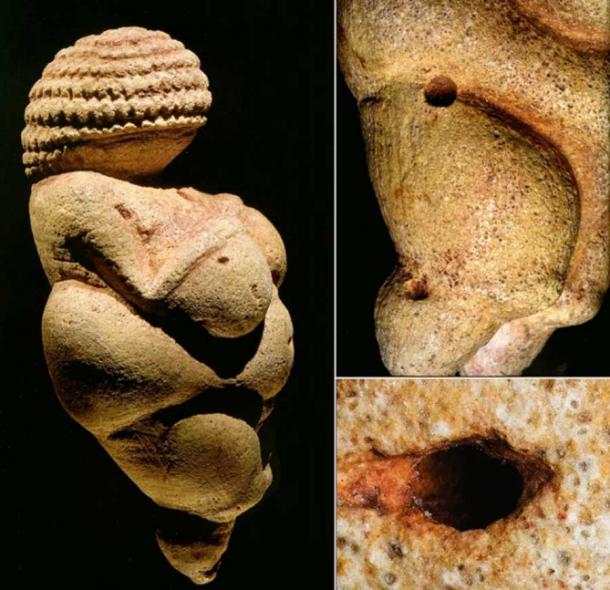
The original Venus from Willendorf. Left: lateral view. Right-top: hemispherical cavities on the right haunch and leg. Right bottom: existing hole enlarged to form the navel. (Lois Lammerhuber / Scientific Reports)
The Oolite Limestone Venus of Willendorf Mystery
The Venus of Willendorf has always been something of an anomaly, because it was made from a type of limestone known as oolite. This was an unusual choice for such a statue, since these types of figurines were usually made from bone or ivory (easier substances to carve). More intriguingly, this type of rock cannot be found anywhere in the region around Willendorf, meaning it had to be imported from somewhere else.
But from where? That has always been the question, and no satisfactory answer had ever been provided—until now, thanks to pioneering research that has uncovered the truth about the origin of the material used to make the Venus of Willendorf.
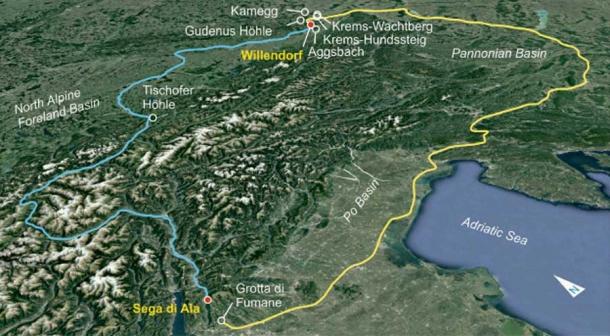
Tentative migration routes from northern Italy to Lower Austria. Sega di Ala is located near the important paleolithic site of Grotta di Fumane, Italy. Willendorf is located near a cluster of paleolithic sites from different epochs in Lower Austria . (Scientific Reports)
Archaeological X-Rays Reveal a Unique Venus “Fingerprint”
Previously, the Venus figurine had only been subject to surface examinations. But Gerhard Weber wanted to get a better look at the interior of the statue, and to do so he tried a high-tech procedure known as micro-computed tomography.
- Stone Age Clothing: Function Over Fashion
- New Evidence Reveals Ice Age Hunters Didn’t Migrate South In Winter
Micro-CT is a three-dimensional imaging process that uses X-rays to see deeply inside an object, narrow slice by narrow slice. Weber used this technology to analyze the statue’s oolite rock interior down to a resolution of an ultra-tiny 11.5 micrometers, which matches the scale that can be obtained with a microscope.
This procedure turned out to be quite useful, as it picked up an oddity that gave the oolite a unique identifying characteristic.
"Venus does not look uniform at all on the inside,” Weber said, in a University of Vienna press release about his research. “[This is] a special property that could be used to determine its origin.”
Geologists Lukeneder and Harzhauser knew a lot about oolites, having examined and analyzed many samples of this rock before. For this research, they obtained samples of oolite mined from locations in Germany, the Ukraine, France, the islands and mainland of Italy, and other parts of Austria. The idea was to see if any distinctive characteristics could be found in these samples that would match the uneven and inconsistent material composition of the Venus oolite.
The researchers digitally analyzed thousands of oolite grain samples, painstakingly and over the course of many months, seeking a “fingerprint” match. Surprisingly, none of the samples taken from within a 125-mile (200-kilometer) radius of Willendorf even remotely resembled the Venus oolite. But when the researchers compared the Venus rock to a sample taken from a spot near Lake Garda in northern Italy, the grains from the two sources were found to be nearly identical.
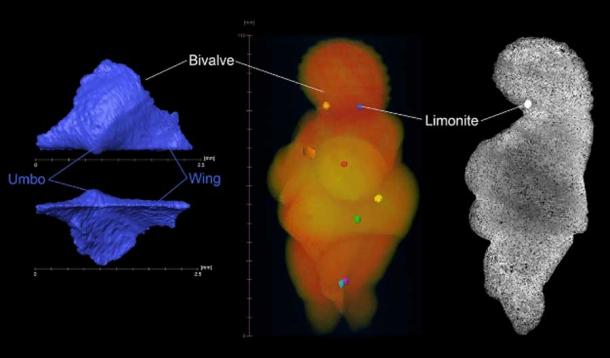
Pictures derived from µCT scans of the Venus of Willendorf. Left: Segmented bivalve (Oxytomidae) that was located on the right side of the Venus head. Middle: Volume rendering of the virtual Venus; six embedded limonite concretions. Right: Single µCT-slice showing the porosity and layering of the oolite; note the relative density of the limonite concretion. (Scientific Reports)
This was a remarkable discovery. It means that either the figurine or the un-sculpted rock had traveled more than 400 miles (650 kilometers) to reach its final destination, passing from south of the Alps to the Danube River north of the Alps. It would have been carried all that way by Paleolithic hunter-gatherers making the entire journey on foot.
"People in the Gravettian—the tool culture of the time—looked for and inhabited favorable locations,” Gerhard Weber explained. “When the climate or the prey situation changed, they moved on, preferably along rivers. Such a journey could have taken generations.”
The scientists have identified two possible routes that could have brought ancient Gravettian culture people from northern Italy to eastern Austria. One would have led them around the foothills of the Alps, avoiding the need to scale any significant heights but adding greater distance onto their ultimate journey. The second route would have actually had them passing over and through the Alps, presumably through relatively low-altitude passes located in the foothills.
While the second possibility is theoretically conceivable, it seems improbable. In addition to encountering inhospitable altitudes, travelers attempting to scale the Alps 25,000 to 30,000 years ago would most likely have been blocked by Alpine glaciers (this was at least 15,000 years before the end of the last Ice Age).
Since migrating Gravettian peoples would not have been trying to reach any particular destination, it would have made more sense to choose the path of least resistance, as they continued their search for fertile and productive hunting and gathering lands to the east.
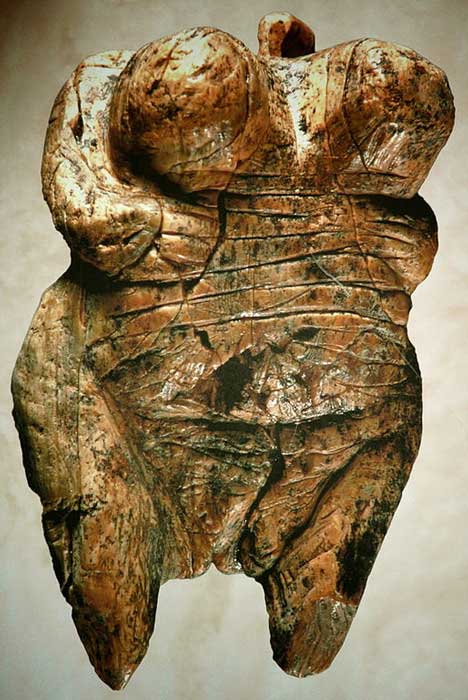
Venus of Hohle Fels, the earliest Venus figurine, is rougher and more distorted than the later Venus of Willendorf . (Ramessos / CC BY-SA 3.0)
The Venus of Willendorf: A Closer Look
The Venus or Woman of Willendorf is one of approximately 40 intact Venus figurines that have been recovered from excavations dating to the Upper Paleolithic time frame (50,000 to 12,000 years before the present). Fragments from dozens more have also been found, showing how widespread the carving of these figures was during prehistoric times.
While the limestone statue dug up near Willendorf is clearly meant to depict a woman, the proportions of its features are distorted. The breasts, stomach, and hips are large and extended, while the arms are short and not fully developed. The statue does have legs, but its feet are missing entirely.
Perhaps the most unusual aspect of the Woman of Willendorf is its lack of facial features. It has a head, but that head is angled forward and covered completely by a braided wrap that could represent either a large headdress or a braided hair style.
The commonality of the statue has led archaeologists and anthropologists to speculate that figurines like this represent a fertility deity or mother goddess, of the type that were worshipped in many cultures across the world in ancient times. These statues always have exaggerated sexual or maternal features, strongly suggesting they represent pregnancy, childbirth, and the procreative process in general. That is why these statues are referred to as Venus figurines, even though the actual goddess Venus didn’t appear in mythology until several thousand years after these statues were created by Paleolithic sculptors.
Most who’ve studied the statue believe it is in fact a type of fertility deity. But one alternative theory claims the statue was created by a female sculptor, who was trying to recreate what a woman’s body would look like if she was looking down at herself. That would explain why the breasts and stomach are large, but the feet and hands nonexistent. The prominence of the hair or headdress and the lack of facial features might represent how a woman looking down at herself would appear to someone standing beside her.
The Upper Paleolithic sculptors who created these striking figurines are not around to answer questions about what they actually mean, or for what purpose they were made. The odd and disproportionate shapes of the statues reveal them to be at least partially abstract, although they obviously represent real aspects of femininity, fertility, and motherhood.
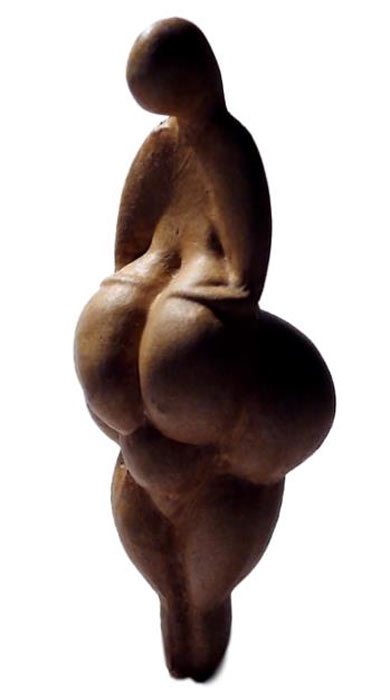
A replica of the Gravettian Venus of Lespugue. The Gravettians produced a large number of Venus figurines. (Locutus Borg / Public domain)
An Unfamiliar Era Ready for Further Study
Up to now, only a few studies have looked more deeply at how early humans would have lived and survived in Austria and the surrounding regions of Europe during Paleolithic times.
The discovery of the truth about the origin of the Venus of Willendorf statue may increase interest in the cultural habits and migratory patterns of those who lived much earlier.
- Breaking News: Earliest Upper Paleolithic Humans in Europe Discovered!
- 13,000-Year-Old Bitumen Dental Fillings Found in Italy: Earliest Example of Dentistry Known to Date
“We want to use these Venus results and our new Vienna research network "Human Evolution and Archaeological Sciences," in cooperation with anthropology, archaeology and other disciplines, to further clarify early history in the Alpine region," Weber said.
The Gravettian tool culture survived for approximately 12,000 years (from 33,000 to 21,000 BC) before finally going into decline, which shows that their cultural, social, and economic practices must have been quite well adapted for the challenging times in which they lived.
Top image: Four views of the Venus of Willendorf, which a recent study proved was made from oolite limestone from a prominent prehistoric site in northern Italy. Source: Bjørn Christian Tørrissen / CC BY-SA 4.0
By Nathan Falde
















Comments
Wow ,talk about beating a dead horse to death. It's nice to know that the original stone material came from 400miles away. Does that mean it was carved there? Maybe. Does that mean the artist carried it that far? Maybe. MAYBE we have little knowledge just how far people moved around, or how important trade and culture disseminated was. Ozzie the ice man has shown we must consider both were far more fluid than we assume from our 'modern' preconceptions. Four hundred miles is not far. Mormon pioneers pushed hand carts from Illinois to Utah!